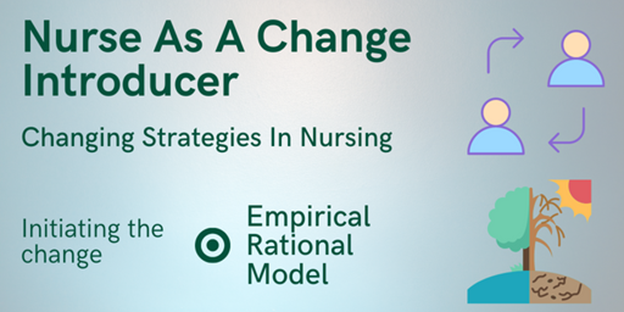The Nurse as Change Agent. And use Power-coercive strategies, Empirical Rational Model and Nurse’s Role Initiate the Change.
The Nurse as Change Agent
Nurses can be powerful change agents in healthcare, advocating for improved patient care, influencing policy, and driving innovation through their expertise and leadership. They can lead teams, promote community health, and foster the redesign of nursing education.
How Nurse Bring Change
A change agent is one who works to bring about a change. Being a change agent, however, is not easy. Although the end result of change may benefit nurses and patients alike, initially it requires time, effort, and energy, all in short supply in the high-stress environment of health care.
Nurse as change agent: Change agent can be a role model for others by touting the positive outcomes of change-improved patient care (Leary & Allen, 2006). The nurse, as an integral part of the system, is key to stimulating the need for change and crucial for the success of planned change (Mathena, 2002).
Changes will continue at a rapid pace with or without nursing’s expert guidance. Nurses, like organizations, cannot afford merely to survive changes. If they are to exist as a distinct profession that has expertise in helping individuals respond to actual or potential health problems, they must be proactive in shaping the future. Opportunities now exist for nurses, especially those in management positions, to change the system about which they complain so often. On the other hand, managers should not initiate change just for the sake of change or to show that they are “managing” (McConnell, 2002).
Change Bringing Strategies
Regardless of the setting or proposed change, the four-step change process should be followed. However, specific strategies can be used, depending on the amount of resistance anticipated and the degree of power the change agent.
Power-coercive strategies
Nurse as change agent: Power-coercive strategies are based on the application of power by legitimate authority, economic sanctions, or political clout. Changes are made through law, policy, or financial appropriations. Those in control enforce changes by restricting budgets or creating policies. Those who are not in power may not even be aware of what is happening. Even if they are aware, they have little power to stop it. The prospective payment system for Medicare (DRGs) was a power-coercive strategy by the federal government. Similarly managed care has changed economic incentives in health care.
The change process continues through the seven steps, but there is little, if any, participation by the Ear get system members. Resistance is handled by authority measures: Accept it, or leave change is critical for organizational survival, power-coercive strategies may be necessary.
Empirical Rational Model
In the empirical-rational model of change strategies, the power ingredient is knowledge. The assumption is that people are rational and will follow their rational self-interest if that self-interest is made clear to them. It is also assumed that the change agent who has knowledge has the expert power to persuade people to accept a rationally justified change that will benefit them. The flow of influence moves from those who know to those who do not know. New ideas are invented and communicated or diffused to all participants. Once enlightened, rational people will either accept or reject the idea based on its merits and consequences. Empirical-rational strategies are often effective when little resistance to the proposed change is expected and the change is perceived as reasonable.
Introduction of new technology that is easy to use, cuts nursing time, and improves quality of care would be readily accepted after in-service education and perhaps a trial use. The change agent can direct the change. There is little need for staff participation in the early steps of the change process, although input is useful for the evaluation and stabilization stages. The benefits of change for the staff and perhaps research findings regarding patient outcomes are the major driving forces. Well-researched, cost-effective technology can be implemented using these strategies.
Normative-Reductive Strategies
Nurse as change agent: In contrast to the rational-empirical model, normative reductive strategies of change rest on the assumption that people act in accordance with social norms and values. Information and rational arguments are insufficient strategies to change people’s patterns of actions; the change agent must focus on noncognitive determinants of behavior as well. People’s roles and relationships, perceptual orientations, attitudes, and feelings will influence their acceptance of change.
In this mode, the power ingredient is not authority or knowledge, but skill in interpersonal relationships. The change agent does not use coercion or nonreciprocal influence, but collaboration. Members of the target system are involved throughout the change process. Value conflicts from all parts of the system are brought into the open and worked through so change can progress. Normative-reductive strategies are well suited to the creative problem solving needed in nursing and health care today. With their firm grasp of the behavioral sciences and communication skills, nurses are comfortable with this model.
Changes From Traditional Way
Changing from a traditional nursing system to self-governance or initiating a home follow-up service for hospitalized patients are examples of changes amenable to the normative-reductive approach. In most cases, the normative-reductive approach to change will be effective in reducing resistance and stimulating personal and organizational creativity. The obvious drawback is the time required for group participation and conflict resolution throughout the change process. When there is adequate time or when group consensus is fundamental to successful adoption of the change, the manager is well advised to adopt this framework.
The Nurse’s Role Initiate the Change
Contrary to popular opinion, change often is not initiated by top-level management (Yukl, 2005), but rather emerges as new initiatives or problems are identified. In fact, Ingersoll et al. (2002) found that mid-level mana Gers had more effect on staff nurses’ perception of change than did the executives. Likewise, Crow (2006) suggests that a partnership between staff and administrators is more effective in producing change than the traditional top-down approach. Staff nurses often think that they are unable to initiate and create change, but that is not so.
The manager, as well, may resist leading change. Afraid of “rocking the boat,” fearful that no one will join our efforts, recalling that past efforts at change had failed, or even the reluctance to become involved may prevent the nurse from initiating change ( Grindle, 2006).
A:Making change is not easy, but it is a mandatory skill for managers. Successful change agents’ demonstrate certain characteristics that can be cultivated and mastered with practice. Among these are:
B :The ability to combine ideas from unconnected sources
The ability to energize others by keeping the interest level up and demonstrating a high personal energy level – Skill in human relations: well-developed interpersonal communication, group management, and problem-solving skills Integrative thinking: the ability to retain a big picture focus while dealing with each part of the system
- Sufficient flexibility to modify ideas when modifications will improve the change, but enough persistence to resist nonproductive tampering with the planned change
- Confidence and the tendency not to be easily discouraged
Realistic thinking
Trustworthiness: a track record of integrity and success with other changes
- The ability to articulate a vision through insights and versatile thinking The ability to handle resistance.
Energy is needed to change a system. Power is the main source of that energy. Informational power, expertise, and possibly positional power can be used to persuade others.
To access optimum power, use the following strategies:
- Analyze the organizational chart. Know the formal lines of authority. Identify informal lines as well.
- Identify key persons who will be affected by the change. Pay attention to those immediately above and below the point of change.
- Find out as much as possible about these key people. What are their tickle points? What interests them, gets them excited, turns them off? What is on their personal and organizational agendas? Who typically aligns with whom on important decisions?
- Begin to build a coalition of support before you start the change process. Identify the key people who will be affected by the change. Talk informally with them to flush out possible objections to your idea and potential opponents. What will the costs and benefits be to them-especially in political terms? Can your idea be modified in ways that retain your objectives but appeals to more key people?
- Follow the organizational chain of command in communicating with administrators. Don’t bypass anyone to avoid having an excellent proposal undermined.
Benefits of Nurse As Change Agent
Nurse as change agent: This information helps you develop the most sellable idea or at least pinpoint probable resistance. It is a broad beginning to the data-collection step of the change process and has to be fine-tuned once the idea is better defined. The branch manager keeps alert at all times to monitor power struggles.
Although a cardinal rule of change is: Don’t try to change too much too fast, the savvy manager develops a sense of exquisite timing by pacing the change according to the political pulse. For example, the manager unfreezes the system during a period of coalition building and high interest, while resistance. is low or at least unorganized.
You may decide to stall the project beyond 2 pilot rage if resistance solidifies or gains a powerful ally. In this case, do whatever you can to reduce resistance. If resistance continues, two options should be considered:
The change is not workable and should be modified to meet the strongest objections (compromise). The change is fine-tuned sufficiently, but change must proceed now and resistance must be overcome.
Read More:
https://nurseseducator.com/dialectic-teaching-with-team-based-learning/
https://nurseseducator.com/high-fidelity-simulation-use-in-nursing-education/
First NCLEX Exam Center In Pakistan From Lahore (Mall of Lahore) to the Global Nursing
Categories of Journals: W, X, Y and Z Category Journal In Nursing Education
AI in Healthcare Content Creation: A Double-Edged Sword and Scary
Social Links:
https://www.facebook.com/nurseseducator/
https://www.instagram.com/nurseseducator/

